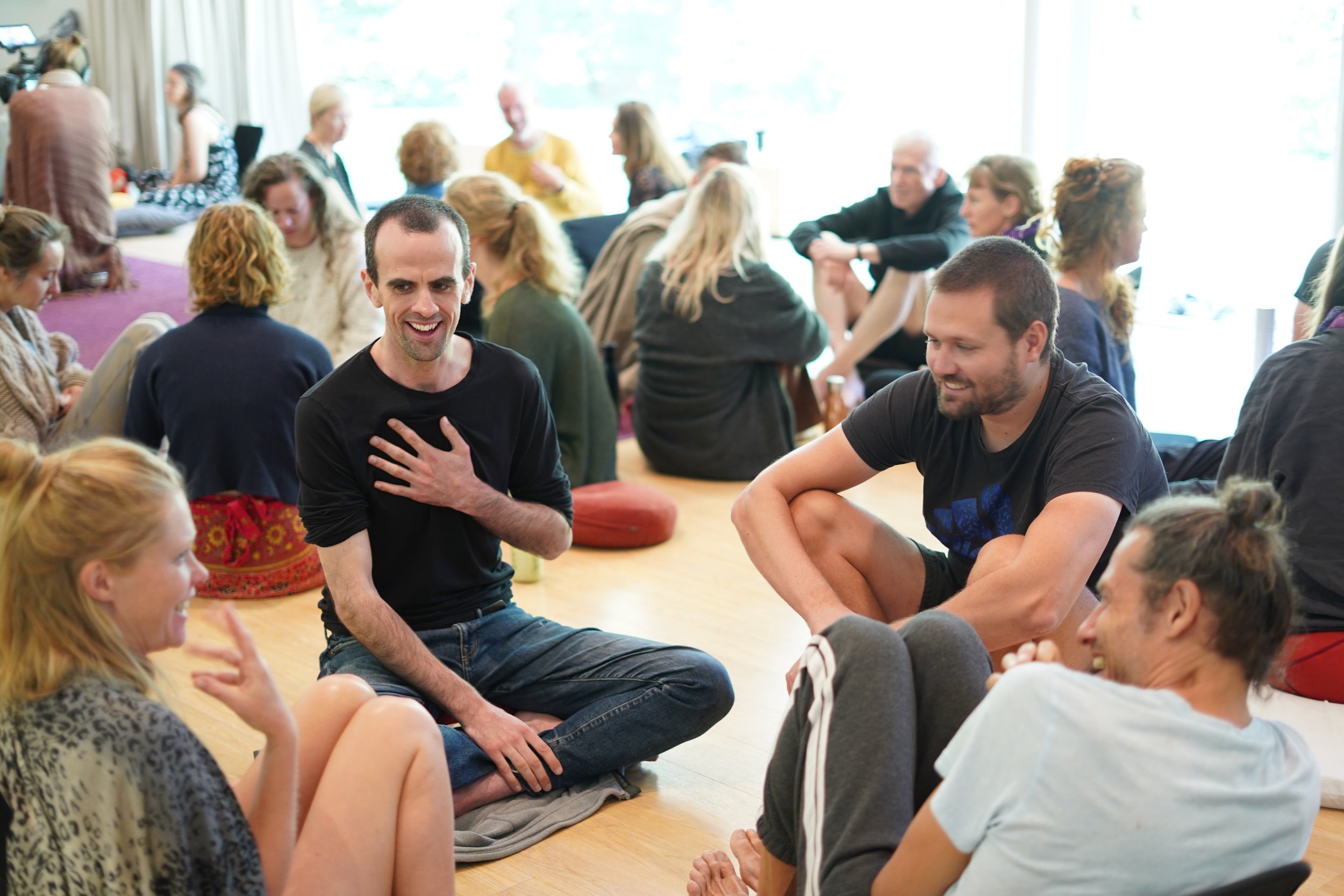Practice 2 - Noticing
This practice is a training for you to become more direct and intimate in your communication with those around you. This often inspires others to also be more present and in the moment. It further develops your capacity to deepen and share your presence with others in a way that is more readily applicable to everyday situations.
Preparation
Start by sitting and facing each other in meditation, and then opening your eyes and making eye contact (see Practice #1, which will build your awareness and help you pick out what you are noticing in the moment).
Instruction
Start to notice your experience while in connection with the other.
You can begin to share what you are noticing in the moment. You can use the sentence stems, "I notice..." and "I’m noticing…", to keep your communication simple and focused.
Try to share what you know to be true—that which is as close to what is inarguably true in your experience. For example: ‘I notice you are sad’ is an interpretation, whereas, ‘I notice you look down every few seconds’ is a truthful observation.
You do not need to take turns; simply let the communication flow as it needs to, with each partner sharing when it feels alive for them to do so. If nothing wants to be shared, simply rest in the silence.
Explore impulses to explain your shares—are you explaining yourself out of habit or fear of judgement? Or does it feel important and alive to express more about what is going on for you?
You might also explore your motivation for sharing what you do and reveal that to your partner, including any desires or expectations you have for an effect or response from them.
Notice how the connection shifts as you do this practice together. How do you feel in yourself and in relation to the other, as you share your-in-the moment experience and receive theirs?
Things you might notice
Bodily sensations.
Feelings and emotions.
The outside world as it comes into your awareness (what you see, hear, smell, taste or touch).
Mind/thought activity.
An expression or movement in your partner.
Your awareness of your noticing habits (meta-awareness).
Examples
‘I notice a buzz in my belly’.
‘I notice your eyes’.
‘I notice I am looking for something to say’.
‘I notice a feeling of anxiousness to speak’.
‘I notice my stomach feels a little tight’.
‘I'm noticing my face is tingling’.
‘I'm noticing when I look into your eyes I feel more connected to your right eye’.
‘I notice I am glad you came to sit next to me’.
‘I'm noticing a feeling of attraction’.
'I'm feeling nervous sitting with you'.
'I'm feeling excitement in my belly'.
'I'm feeling sad and a bit angry'.
‘I’m noticing how I rarely notice bodily sensations’.
Why this practice is powerful
There is a simple magic and an intimacy in bringing our attention to what is happening as it is occurring, and sharing that with another. When we do this, we discover something new together, something that has never been before—a taste of the mystery of the ever present creativity of the universe. This is always the case with presence, but there’s an extra joy of being able to share that in relationship.
Sharing what you are noticing can create a bridge between you and the other person. It also encourages authenticity by putting the focus on sharing something that is actually present, rather than something that is a tactic to create a particular image of yourself or to control the response from the other. For example: Saying something to look good, to bring the other closer, or to appear intelligent or present.
In addition, this practice helps you to own your experience and not get caught up with projecting onto others. This means you are only speaking for what you notice, leaving space for the other's experience to be something different. This gives room and freedom for both of you in the connection.
How to deepen
There is almost always more depth of connection and intimacy if:
What is shared is happening in the present moment.
More emotion/feeling is expressed.
There is more openness to different interpretations from the other.
You speak from your own experience, and are willing to stay with the vulnerability of sharing and feeling the impact of doing so, rather than explaining yourself.
You wait until there is really something you would like to share, rather than just speaking whenever there is silence—this is a deeper practice and will bring more authenticity and aliveness to what you share.
The depth and intensity of the connection is often lessened by
Generalising what you are feeling and not owning it as yours.
(This will often cause friction and less connection. For example, compare the impact of: ’It’s boring here’, to ‘I’m noticing I am feeling irritated’. The first one is assessing the outside and giving little space for a different perspective, whereas the second gives room for others to have a different interpretation, and reveals more of yourself for them to see. This builds trust and means that your communication more closely reflects what is actually happening in you.)
Trying hard to find something to say.
(This often means you are making connection happen rather than being open to what is already here. If this is happening, there is often anxiety or another uncomfortable feeling that you are not noticing. By revealing your tendency to try, you may be able to access and reveal the feeling underneath. This will create a deeper level of connection with yourself and the other person.)
Holding back from expressing uncomfortable and difficult feelings for fear of how the other will receive them.
Bringing these insights into your life
The practice of noticing and sharing your experience invites you to go into deeper places in yourself, and from here there are more possibilities to connect deeply with others. This presents you with many opportunities to learn more about yourself and how you impact people.
It isn’t often (in everyday communication) that we are told how our way of being is impacting the other at the level of bodily sensation, or even emotion. It can be vulnerable to share with another that we are experiencing a difficult, painful, or even pleasurable sensation in connection with them. Sharing this changes what is possible in relationship and allows more growth for each individual and the potential for closeness.
This is also hugely empowering because it gives you access to deeper levels of self-awareness and self knowledge. In this way, Circling practice points to life and connection being a journey of discovery—rather than just you living life, you are allowing life to live you. At the heart of the practice is the invitation to surrender—to trust life as it is unfolding, and to let a deeper part of our being become the guide.

